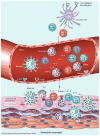Diagnostic and therapeutic strategies for eosinophilic esophagitis
- PMID: 25400904
- PMCID: PMC4230789
- DOI: 10.2217/cpr.14.31
Diagnostic and therapeutic strategies for eosinophilic esophagitis
Abstract
Eosinophilic esophagitis (EoE) is a recently recognized allergic disorder, characterized by eosophageal dysfunction, accumulation of ≥15 eosinophils/high-powered field, eosinophil microabssess, basal cell hyperplasia, extracellular eosinophilic granules in the esophageal epithelial mucosal biopsy and a lack of response to a 8-week proton pump inhibitor treatment. Despite the increased incidences and considerable progress made in understanding EoE pathogenesis, there are limited diagnostic and therapeutic options available for EoE. Currently, the only criterion for diagnosing EoE is repetitive esophageal endoscopic biopsies and histopathological evaluation. Antigen elimination or corticosteroid therapies are effective therapies for EoE but are expensive and have limitations, if continued in the long term. Hence, there is a great necessity for novel noninvasive diagnostic biomarkers that can easily diagnose EoE and assess effectiveness of therapy. Herein, we have provided an update on key molecules involved in the disease initiation, and progression and proposed novel noninvasive diagnostic molecules and strategies for EoE therapy.
Keywords: basophils; eosinophil; esophagitis; interleukin; invariant natural killer T cells; mast cell.
Figures

Similar articles
-
Elements Involved In Promoting Eosinophilic Gastrointestinal Disorders.J Genet Syndr Gene Ther. 2015 Aug;6(2):265. doi: 10.4172/2157-7412.1000265. Epub 2015 Aug 7. J Genet Syndr Gene Ther. 2015. PMID: 27840774 Free PMC article.
-
Longitudinal Evaluation of Noninvasive Biomarkers for Eosinophilic Esophagitis.J Clin Gastroenterol. 2017 Feb;51(2):127-135. doi: 10.1097/MCG.0000000000000621. J Clin Gastroenterol. 2017. PMID: 27479142
-
Optimal Biopsy Protocol to Evaluate Histological Effectiveness of Proton Pump Inhibitor Therapy in Patients with Eosinophilic Esophagitis.Digestion. 2019;100(1):64-71. doi: 10.1159/000494253. Epub 2018 Nov 8. Digestion. 2019. PMID: 30408792
-
Eosinophilic Esophagitis: Impact of Latest Insights Into Pathophysiology on Therapeutic Strategies.Dig Dis. 2016;34(5):462-8. doi: 10.1159/000445201. Epub 2016 Jun 22. Dig Dis. 2016. PMID: 27333298 Review.
-
Eosinophilic esophagitis in adults and adolescents: epidemiology, diagnostic challenges, and management strategies for a type 2 inflammatory disease.Therap Adv Gastroenterol. 2024 May 27;17:17562848241249570. doi: 10.1177/17562848241249570. eCollection 2024. Therap Adv Gastroenterol. 2024. PMID: 38812705 Free PMC article. Review.
Cited by
-
Allergen-induced interleukin-18 promotes experimental eosinophilic oesophagitis in mice.Immunol Cell Biol. 2015 Nov;93(10):849-57. doi: 10.1038/icb.2015.30. Epub 2015 Mar 24. Immunol Cell Biol. 2015. PMID: 25801352 Free PMC article.
-
Involvement of interleukin-18 in the pathogenesis of human eosinophilic esophagitis.Clin Immunol. 2015 Apr;157(2):103-13. doi: 10.1016/j.clim.2015.01.007. Epub 2015 Jan 28. Clin Immunol. 2015. PMID: 25638412 Free PMC article.
-
Food protein-induced allergic proctocolitis in infants: Literature review and proposal of a management protocol.World Allergy Organ J. 2020 Oct 1;13(10):100471. doi: 10.1016/j.waojou.2020.100471. eCollection 2020 Oct. World Allergy Organ J. 2020. PMID: 33072241 Free PMC article. Review.
-
Neuroendocrine cells derived chemokine vasoactive intestinal polypeptide (VIP) in allergic diseases.Cytokine Growth Factor Rev. 2017 Dec;38:37-48. doi: 10.1016/j.cytogfr.2017.09.002. Epub 2017 Sep 23. Cytokine Growth Factor Rev. 2017. PMID: 28964637 Free PMC article. Review.
-
Elements Involved In Promoting Eosinophilic Gastrointestinal Disorders.J Genet Syndr Gene Ther. 2015 Aug;6(2):265. doi: 10.4172/2157-7412.1000265. Epub 2015 Aug 7. J Genet Syndr Gene Ther. 2015. PMID: 27840774 Free PMC article.
References
-
- Landres RT, Kuster GG, Strum WB. Eosinophilic esophagitis in a patient with vigorous achalasia. Gastroenterology. 1978;74(6):1298–1301. - PubMed
-
- Attwood SE, Smyrk TC, Demeester TR, Jones JB. Esophageal eosinophilia with dysphagia. A distinct clinicopathologic syndrome. Digest Dis Sci. 1993;38(1):109–116. Primarily defines eosinophilic esophagitis (EoE) as a characteristic clinicopathological syndrome. - PubMed
-
- Furuta GT, Liacouras CA, Collins MH, et al. Eosinophilic esophagitis in children and adults: a systematic review and consensus recommendations for diagnosis and treatment. Gastroenterology. 2007;133(4):1342–1363. - PubMed
-
- Liacouras CA, Furuta GT, Hirano I, et al. Eosinophilic esophagitis: updated consensus recommendations for children and adults. J Allergy Clin Immunol. 2011;128(1):3–20. e26. quiz 21–22. Provides the updated consensus recommendations for EoE of children and adults, and discussed further advances and controversies regarding diagnostic methods, surrogate disease markers, allergy testing and treatment approaches. - PubMed
Grants and funding
LinkOut - more resources
Full Text Sources
Other Literature Sources
